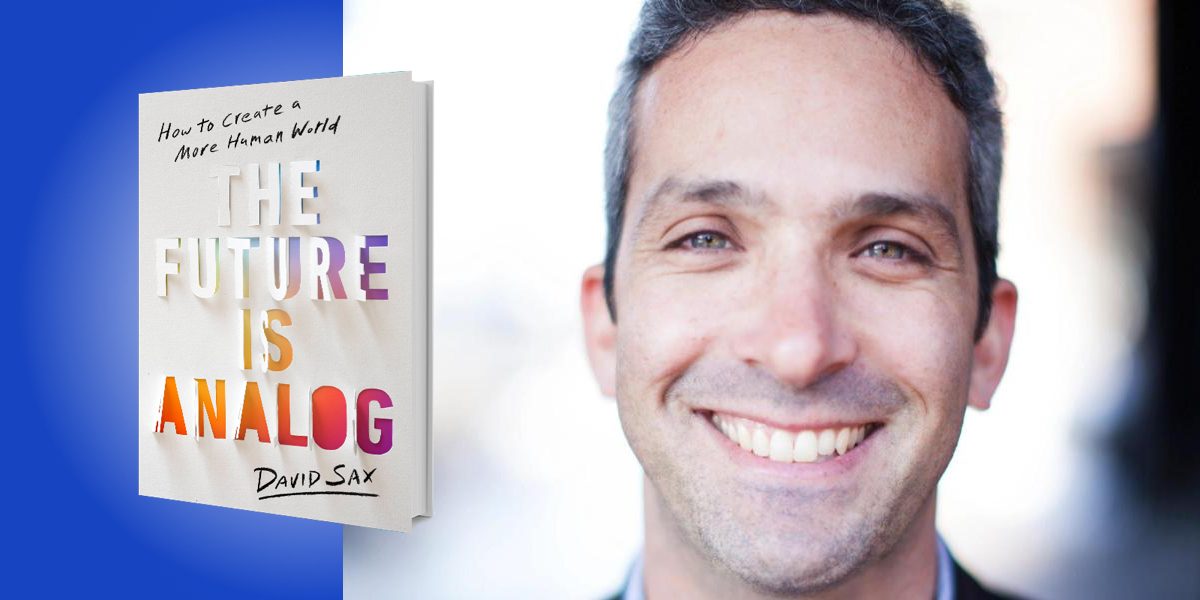David Sax is a journalist, author, and speaker. He has written for The New York Times, Vanity Fair, Bloomberg Business, and NPR, among other publications.
Below, David shares 5 key insights from his new book, The Future is Analog: How to Create a More Human World. Listen to the audio version—read by David himself—in the Next Big Idea App.
1. Don’t get distracted by gadgets.
When I was growing up in the 80s and the 90s, the future was something I saw through technology—through gadgets. I thought of seeing new consumer products like cell phones and smartphones, CD-ROMs and the internet. Even the pop culture that I was into, like Star Trek and Star Wars movies, were about the technology they had: the communicators and the phasers, and the three seashells that cleaned your butt in Demolition Man.
So much of the way we look at the future is focused on technology. But we tend to lose focus when we view the future through the lens of technology. Remember when CD-ROMs were the big thing that was going to change the world? Or how every company was going to be completely transformed by big data? And wearables were going to change healthcare?
Little, if none, of those predictions came to pass, but we put so much effort into building solutions around the future of those technologies that we lost sight of bigger trends. Viewing the future through a new technology narrows our vantage of the future, because the future is only being built through the lens of what that particular technology is capable of.
The bigger trends will affect our future—at a species level. Gadgets that are cool make for great presentations and TV commercials, but the really big stuff that changes the world is far more complex and dynamic, and relates to us more on a human level. For instance, the slowly rising level of carbon dioxide in the atmosphere has a real impact on the survival of our species. Or the changing dynamics of disease and habitat loss which lead to crises like pandemics. There are also shifting attitudes toward political ideals, or attitudes towards racism.
“Viewing the future through a new technology narrows our vantage of the future, because the future is only being built through the lens of what that particular technology is capable of.”
When we think, “Oh, well, the future is going to be this cool new, shiny thing I saw an ad for,” we are at risk of traveling down dangerous trajectories. Instead, face the real future by staying tethered to the big trends that matter.
2. Be honest about the future you want versus the future you’re told to want.
No one loves selling us on a future more than the people inventing and promoting new products or services. Steve Jobs was the master of this, getting on a stage to preach about the future that he was unveiling with the latest iPod, tablet, or software update. This tactic of “this will change the world” messaging has been similarly replicated by anyone pitching something.
For much of the past century, there have been people pitching different technologies as the future of education. Thomas Edison was known for selling phonographs, radio transmissions, and film lectures as the future of schools. He said, “We wouldn’t need schools, we wouldn’t need buildings, we wouldn’t need teachers. Everything would be filmed and people would be able to just watch it and they would be educated.” This is no different from the EdTech business (think Chegg, Duolingo, or Coursera), which is a multi-billion dollar industry that has grown up around Silicon Valley for the past couple of decades. There was a time when CD-ROMs were considered the future of education. There was the era of “one laptop per child” becoming the future of education, and the idea was literally to drop hand-cranked laptops from airplanes into remote villages in Africa. You had the MOOC (Massive Online Open Courses) movement of Sebastian Thorn and the people from Google who would film great lectures from universities and offer them online as free-to-watch.
All of these pitches on education leading up to the pandemic were failures. Yet, they were consistently pushed as the future that you’re going to want: the future that is good for schools, and will make education equal and better. But when every student in the world, from kindergarten to university, went online because of the pandemic, it was a horrible global failure. Nobody liked learning that way. Nobody did very well, and everyone was tearing their hair out trying to send their kids or themselves back to school.
The reality of a certain future that is pitched is often very different from the sales front. You have to be honest about the future you actually want and fight for that future. You don’t have to accept the future you are told to want.
3. Progress is often something old brought back as something new and shiny.
The future of transportation, as we’ve heard for the past decade, is self-driving, intelligent, electric cars. Cities and countries have been twisting themselves around to be the leaders in this arena: the first to adopt it, to build their infrastructure around fleets of self-driving cars. We’ve been told that this new way will solve traffic and congestion, pedestrian safety, and underfunded public transit systems. One city even said smart cars will be the solution to miscarriages and the deaths of young Black children in underserved areas because self-driving cars will drive them to the hospital.
“Look for the most innovative and transformative ideas that are the most timeless ones because those will actually build a better future.”
But during the pandemic, we learned that the biggest impact on the future of transport in cities is not new tech, it’s old tech. It’s the bicycle, which has been around for well over a century. When you look at the most progressive and successful cities in the world that have transformed their urban landscape to make them safer, cleaner, more efficient, and more livable, it’s cities like Paris, Copenhagen, New York City, and Montreal, which ripped up the infrastructure of cars. Those cities made it more difficult and expensive to drive and replaced car lanes with thousands of kilometers of bike lanes. They took something that was largely an analog technology, studied the results of embracing it, and chose to undo a lot of the so-called technological progress of mid-20th century urban planning—the days of “let’s put a highway through it.”
We saw a similar rewinding in other arenas during the pandemic, such as people falling in love with sourdough baking. The rise in this hobby was literally undoing the technological progress of what it took to develop plain white Wonder Bread, which lasts for two weeks. A wave of people instead learned to make bread as it was done hundreds of years ago. Another way the pandemic reverted progress was with the opening of patios in front of restaurants, which is a feature that in large part disappeared after cities regulated them to make parking spaces. So don’t pigeonhole progress as only new, shiny gadgets or increasingly complicated systems. Look for the most innovative and transformative ideas that are the most timeless ones because those will actually build a better future.
4. No future is inevitable.
In the world of digital technology, we’ve become used to the axiom of Moore’s Law. This is the calculation by Intel co-founder Gordon Moore that circuits are going to shrink in half every 18 months and get twice as powerful and twice as cheap. This is sort of the immutable law that says the growth of any technology is exponential. We’ve seen it in the growth of music streaming, for example, or the growth of internet usage. But Moore’s law is applicable to everything in the future. Once a trend is going in one direction, it inevitably keeps going.
A couple of years ago, Marc Andreessen, the famous venture capitalist and founder of Netscape, claimed in 2009 that the future of all shopping is online. E-commerce would be pretty much the only way we purchase things within a decade’s time and every brick-and-mortar store would close. E-commerce steadily grew over the past two decades with the rise of companies like Amazon, but then, boom, the pandemic started and e-commerce experienced a massive explosion. Everybody had to order everything online. E-commerce growth jumped from 13 percent to 16 percent as people were even buying groceries online. It seemed the inevitable end of retail stores.
How many times did we hear that this is the new normal and there’s no going back? Yet as soon as stores opened, there were lines outside of them. People returned to the grocery store for food that they could just as easily have ordered online. They wanted to be able to touch and feel and do the things that they couldn’t do online.
“We build the future we want, and that future is less binary than we think.”
E-commerce growth has not only stalled but turned back to nearly pre-pandemic levels because it wasn’t that people actually wanted e-commerce. There was a limit to what e-commerce could deliver to the consumer experience. And that’s okay. This doesn’t mean that e-commerce is doomed or disappearing, just that it’s only ever going to be a part of the way we shop, and never the entire thing. No future is inevitable. We build the future we want, and that future is less binary than we think. Simplistic thinking would equal a simplistic future, but that never arrives.
5. The future has human needs, and the future is human.
During the pandemic, we were told that the digital future had arrived: we worked from home, our kids learned from home, we could watch performances, plays, religious services, and concerts from the comfort of home, and we could have anything delivered to us.
But suddenly, as we were doing this, we realized that we needed more. Our bodies craved movement among trees and in the fresh air, not just spinning on a stationary bicycle in our house looking at a screen of someone else spinning on their bicycle. Our minds needed engagement with other people in front of our faces. We weren’t satisfied talking to our friends or relatives on various screens. The entirety of that notion of the digital future (the whole thing that Mark Zuckerberg through Meta Corporation is currently embracing as they try to develop the perfect virtual future) was a false one that’s doomed to fail because we fundamentally are human beings.
We are not some piece of software or an abstract concept. We are biological, physical creatures with bodies that live in a physical world that has senses and smells, and our body responds to that. Our mind responds to that in a way we can’t substitute with simulations. We can’t build a future around a technology that replaces what we as humans need, nor should we want to.
Your future has human needs. If you’re thinking about your own future as an individual or the future of your company, you need to realize that if that future doesn’t serve the genuine needs of humans—actual physical creatures who are in their own little lives and homes and communities and natural areas of the world—if that future doesn’t nourish their bodies and souls with the physical stimulation, mental stimulation, and sense of community that we need, then the future that you’re trying to build will fall short. What is the future that you want to live in and what is the future that you want to build?
To listen to the audio version read by author David Sax, download the Next Big Idea App today:

































